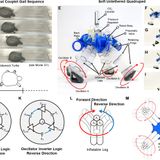RECENT ARTICLES

Electronics-free pneumatic circuits for controlling soft-legged robots
Pneumatically actuated soft robots have recently shown promise for their ability to adapt to their environment. Previously, these robots have been controlled with electromechanical components, such as valves and pumps, that are typically bulky and expensive. Here, we present an approach for controlling the gaits of soft-legged robots using simple pneumatic circuits without any electronic components. This approach produces locomotive gaits using ring oscillators composed of soft valves that generate oscillating signals analogous to biological central pattern generator neural circuits, which...…Pneumatically actuated soft robots have recently shown promise for their ability to adapt to their environment. Previously, these robots have been controlled with electromechanical components, such as valves and pumps, that are typically bulky and expensive. Here, we present an approach for controlling the gaits of soft-legged robots using simple pneumatic circuits without any electronic components. This approach produces locomotive gaits using ring oscillators composed of soft valves that generate oscillating signals analogous to biological central pattern generator neural circuits, which...WW…

Controlled levitation of nanostructured thin films for sun-powered near-space flight
We report light-driven levitation of macroscopic polymer films with nanostructured surface as candidates for long-duration near-space flight. We levitated centimeter-scale disks made of commercial 0.5-micron-thick mylar film coated with carbon nanotubes on one side. When illuminated with light intensity comparable to natural sunlight, the polymer disk heats up and interacts with incident gas molecules differently on the top and bottom sides, producing a net recoil force. We observed the levitation of 6-mm-diameter disks in a vacuum chamber at pressures between 10 and 30 Pa. Moreover, we...…We report light-driven levitation of macroscopic polymer films with nanostructured surface as candidates for long-duration near-space flight. We levitated centimeter-scale disks made of commercial 0.5-micron-thick mylar film coated with carbon nanotubes on one side. When illuminated with light intensity comparable to natural sunlight, the polymer disk heats up and interacts with incident gas molecules differently on the top and bottom sides, producing a net recoil force. We observed the levitation of 6-mm-diameter disks in a vacuum chamber at pressures between 10 and 30 Pa. Moreover, we...WW…

3D printed deformable sensors
The ability to directly print compliant biomedical devices on live human organs could benefit patient monitoring and wound treatment, which requires the 3D printer to adapt to the various deformations of the biological surface. We developed an in situ 3D printing system that estimates the motion and deformation of the target surface to adapt the toolpath in real time. With this printing system, a hydrogel-based sensor was printed on a porcine lung under respiration-induced deformation. The sensor was compliant to the tissue surface and provided continuous spatial mapping of deformation via...…The ability to directly print compliant biomedical devices on live human organs could benefit patient monitoring and wound treatment, which requires the 3D printer to adapt to the various deformations of the biological surface. We developed an in situ 3D printing system that estimates the motion and deformation of the target surface to adapt the toolpath in real time. With this printing system, a hydrogel-based sensor was printed on a porcine lung under respiration-induced deformation. The sensor was compliant to the tissue surface and provided continuous spatial mapping of deformation via...WW…
- Total 3 items
- 1